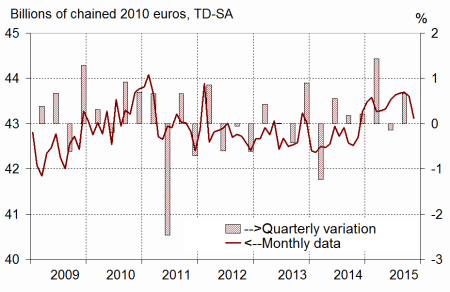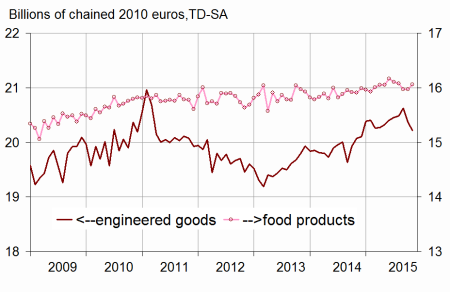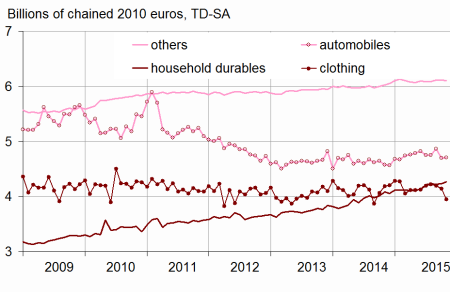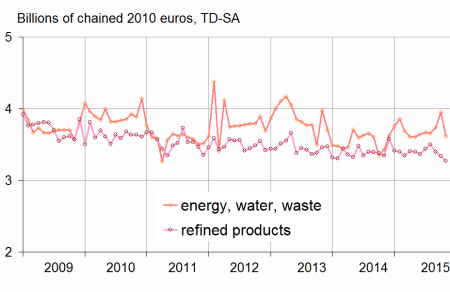 23 December 2015
2015- n° 323In November 2015, household consumption of goods decreased again (–1.1%) Household consumption expenditure on goods - November 2015
23 December 2015
2015- n° 323In November 2015, household consumption of goods decreased again (–1.1%) Household consumption expenditure on goods - November 2015
In November 2015, household expenditure on goods declined again: it decreased by 1.1% in volume*, its largest contraction since January 2014, after a slight fall in October (–0.2%). This drop comes mainly from the slide in energy consumption (–5.6%) and from the sharp decline in spending on textile-clothing (–4.7%).
In November 2015, household expenditure on goods declined again: it decreased by 1.1% in volume*, its largest contraction since January 2014, after a slight fall in October (–0.2%). This drop comes mainly from the slide in energy consumption (–5.6%) and from the sharp decline in spending on textile-clothing (–4.7%).
Energy: sharp decrease
In November, expenditure on energy fell back considerably (–5.6% after +2.2%); its largest decrease since June 2013. The average temperatures in November were particularly mild after being cooler in October, leading to a drop in heating expenditure. Thus, spending on gas and electricity diminished sharply. Consumption of refined products kept decreasing (–2.0%), in particular the one of butane/propane and domestic heating oil.
Engineered goods: decreasing again
In November, purchases of engineered goods kept declining (–0.8% after –1.3% in October), mainly because of textile-clothing.
Textile-clothing: sharp fall
Expenditure on textile-clothing went down for the third consecutive month. This decline was abrupt: –4.7%, (after –1.2% in October and –0.6% in September), likely as a result of mild temperatures.

[* Volumes are chained and all figures are trading days and seasonally adjusted.]
graphiquegraph1_new_ang – Total consumption of goods

- Source: INSEE
graphiquegraph2_new_ang – Food and engineered goods

- Source: INSEE
graphiquegraph3_new_ang – Breakdown of engineered goods

- Source: INSEE
Durables: slight rebound
In November, expenditure on durable goods rebounded slightly (+0.5% after –2.0% in October). Car purchases stabilised after the sharp decrease in October (+0.1% after –3.5%). Expenditure on household durables accelerated (+0.7% after +0.2% in October). Among the other durable goods, purchases of jewelry increased.
Other engineered goods: stability
In November, expenditure on other engineered goods was stable for the second consecutive month. As in October, expenditure on hardware diminished whereas perfume purchases grew.
Food products: increasing for the first time in five months
In November, the consumption of food products was up (+0.6%) for the first time since June 2015. The increased consumption of manufactured food products explained primarily this rebound.
The variation in October 2015 is raised
The variation of household expenditure on goods in October 2015 is revised upwards by 0.5%: –0.2% instead of –0.7%. Indeed, since the publication in November 2015, new information has been integrated, mainly regarding energy, and the seasonal adjustment coefficients have been updated.
graphiquegraph4_new_ang – Energy

- Source: INSEE
tableautab1_eng – Household consumption expenditure on goods
| Weight (1) | Sept. | Oct. | Nov. | Nov. 15 / Nov. 14 | Q / Q-1 (2) | |
|---|---|---|---|---|---|---|
| Food products | 38 | –0.7 | 0.0 | 0.6 | 1.0 | –0.7 |
| Engineered goods | 44 | 0.7 | –1.3 | –0.8 | 0.7 | –0.2 |
| - Inc. Durables | 21 | 1.5 | –2.0 | 0.5 | 3.1 | 0.3 |
| - Automobiles | 11 | 2.5 | –3.5 | 0.1 | 2.9 | –0.3 |
| - Household durables | 7 | 0.0 | 0.2 | 0.7 | 4.6 | 1.2 |
| - Inc. Textile-clothing | 10 | –0.6 | –1.2 | –4.7 | –5.6 | –2.0 |
| - Inc. Other engineered goods | 13 | 0.4 | 0.0 | 0.0 | 1.4 | 0.3 |
| Energy | 18 | –0.2 | 2.2 | –5.6 | 1.6 | 0.3 |
| - Inc. Energy, water, waste | 10 | 2.2 | 5.7 | –8.4 | 5.3 | 3.1 |
| - Inc. Refined Products | 9 | –2.9 | –1.9 | –2.0 | –2.3 | –2.9 |
| Total | 100 | 0.0 | –0.2 | –1.1 | 1.0 | –0.3 |
| - Inc. Manufactured goods | 85 | –0.1 | –0.8 | –0.4 | 0.8 | –0.5 |
- (1) Weighting in the consumption expenditure on goods in value
- (2) Last three months / previous three months
- Source: INSEE
Documentation
Methodology (pdf,23 Ko)




